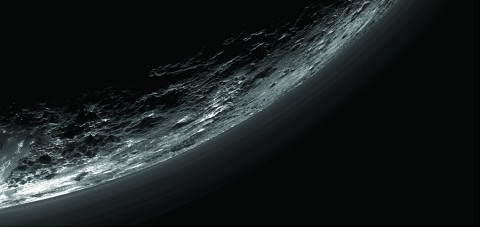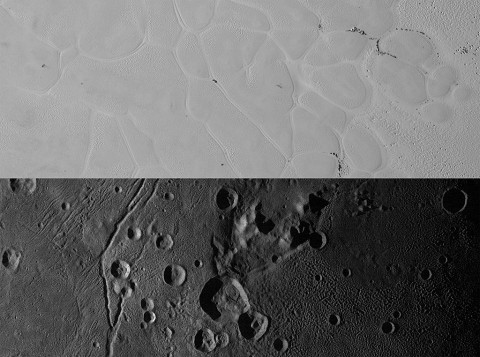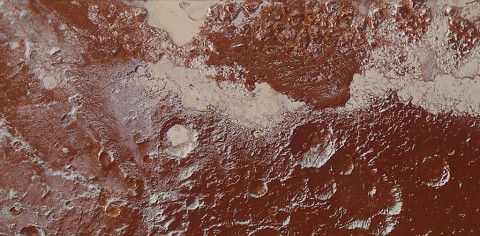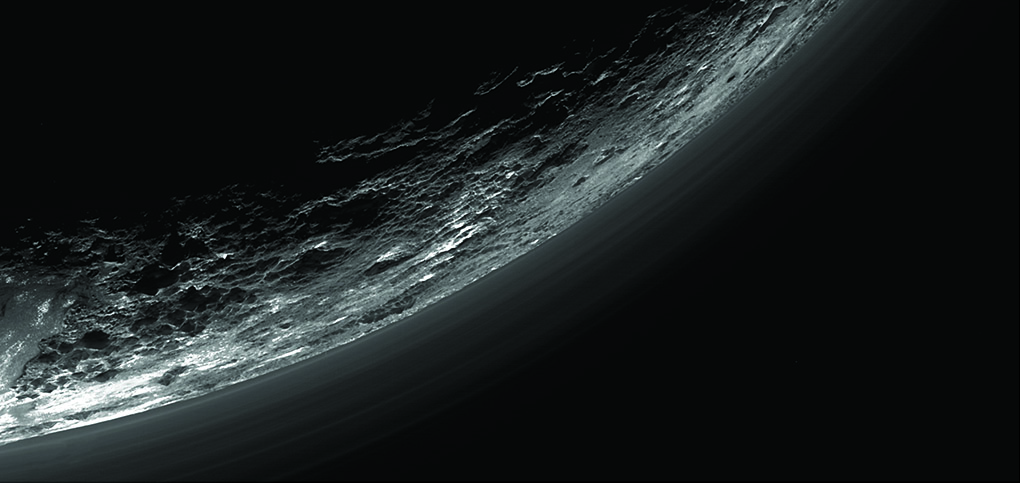NASA Headquarters
 Washington, D.C. – A year ago, Pluto was just a bright speck in the cameras of NASA’s approaching New Horizons spacecraft, not much different than its appearances in telescopes since Clyde Tombaugh discovered the then-ninth planet in 1930.
Washington, D.C. – A year ago, Pluto was just a bright speck in the cameras of NASA’s approaching New Horizons spacecraft, not much different than its appearances in telescopes since Clyde Tombaugh discovered the then-ninth planet in 1930.
But this week, in the journal Science, New Horizons scientists have authored the first comprehensive set of papers describing results from last summer’s Pluto system flyby.

After a 9.5-year, 3-billion-mile journey – launching faster and traveling farther than any spacecraft to reach its primary target – New Horizons zipped by Pluto on July 14th, 2015. New Horizons’ seven science instruments collected about 50 gigabits of data on the spacecraft’s digital recorders, most of it coming over nine busy days surrounding the encounter.
The first close-up pictures revealed a large heart-shaped feature carved into Pluto’s surface, telling scientists that this “new” type of planetary world – the largest, brightest and first-explored in the mysterious, distant “third zone” of our solar system known as the Kuiper Belt – would be even more interesting and puzzling than models predicted.

The newly published Science papers bear that out; click here for a list of top results.
“Observing Pluto and Charon up close has caused us to completely reassess thinking on what sort of geological activity can be sustained on isolated planetary bodies in this distant region of the solar system, worlds that formerly had been thought to be relics little changed since the Kuiper Belt’s formation,” said Jeff Moore, lead author of the geology paper from NASA’s Ames Research Center, Moffett Field, California.
Scientists studying Pluto’s composition say the diversity of its landscape stems from eons of interaction between highly volatile and mobile methane, nitrogen and carbon monoxide ices with inert and sturdy water ice.
Above the surface, scientists discovered Pluto’s atmosphere contains layered hazes, and is both cooler and more compact than expected. This affects how Pluto’s upper atmosphere is lost to space, and how it interacts with the stream of charged particles from the sun known as the solar wind.
“We’ve discovered that pre-New Horizons estimates wildly overestimated the loss of material from Pluto’s atmosphere,” said Fran Bagenal, from the University of Colorado, Boulder, and lead author of the particles and plasma paper. “The thought was that Pluto’s atmosphere was escaping like a comet, but it is actually escaping at a rate much more like Earth’s atmosphere.”

SwRI’s Randy Gladstone of San Antonio is the lead author of the Science paper on atmospheric findings. He added, “We’ve also discovered that methane, rather than nitrogen, is Pluto’s primary escaping gas. This is pretty surprising, since near Pluto’s surface the atmosphere is more than 99 percent nitrogen.”
Scientists also are analyzing the first close-up images of Pluto’s small moons—Styx, Nix, Kerberos and Hydra. Discovered between 2005 and 2012, the four moons range in diameter from about 25 miles (40 kilometers) for Nix and Hydra to about six miles (10 kilometers) for Styx and Kerberos. Mission scientists further observed that the small satellites have highly anomalous rotation rates and uniformly unusual pole orientations, as well as icy surfaces with brightness and colors distinctly different from those of Pluto and Charon.
“These latter two results reinforce the hypothesis that the small moons formed in the aftermath of a collision that produced the Pluto-Charon binary system,” said Hal Weaver, New Horizons project scientist from the Johns Hopkins University Applied Physics Laboratory in Laurel, Maryland, and lead author of the Science paper on Pluto’s small moons.
About half of New Horizons’ flyby data has now been transmitted home – from distances where radio signals at light speed need nearly five hours to reach Earth – with all of it expected back by the end of 2016.
“This is why we explore,” said Curt Niebur, New Horizons program scientist at NASA Headquarters in Washington. “The many discoveries from New Horizons represent the best of humankind and inspire us to continue the journey of exploration to the solar system and beyond.”



